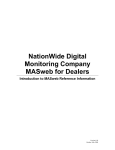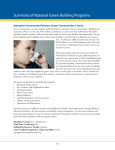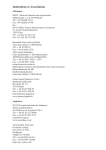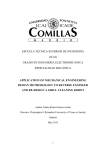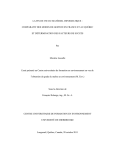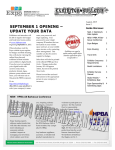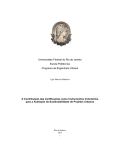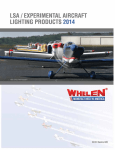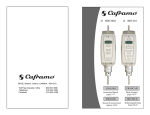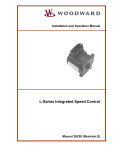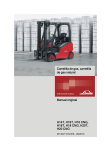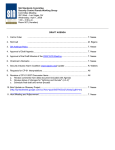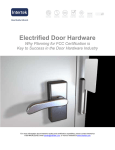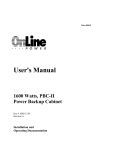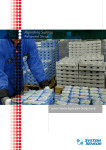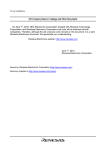Download The Essential Guide to Product Testing
Transcript
The Essential Guide to Product Testing & Certification 2014/2015 North American Edition For more information: 1-800-WORLDLAB [email protected] The Essential Engineering Guide to Product Testing & Certification; 2014/2015 Edition Contents Introduction.............................................................................................................. 2 Selling Electrical or Electronic Products in North America ...................................... 2 OSHA and the NRTL Program ................................................................................ 2 Choosing an NRTL .................................................................................................. 7 Product Marking ...................................................................................................... 8 Field Labeling vs. Limited Production Certification (LPC)...................................... 13 Limited Production Certification (LPC) .................................................................. 14 Other Marks........................................................................................................... 15 Certification for Canada ......................................................................................... 16 Certification for Mexico: NOM................................................................................ 17 What is the Process for ETL Certification and Listing? .......................................... 19 Information Regarding “Counterfeit Marks” ........................................................... 24 International Testing & Certification....................................................................... 26 Considering Global Markets? 5 Key Strategies To Going Global .......................... 26 Glossary ................................................................................................................ 33 Summary ............................................................................................................... 44 Sources ................................................................................................................. 44 www.intertek.com 1 The Essential Engineering Guide to Product Testing & Certification; 2014/2015 Edition Introduction You’ve designed your equipment in line with the relevant Standards governing your product. Now you have a responsibility (in many cases a mandatory requirement) to get your product tested and certified (“Listed”) by an independent body recognized for its competency in electrical or mechanical safety. This allows you to sell your product in the markets you wish to enter, and lets retailers feel comfortable about stocking it on their shelves. This white paper provides information, insights, and a collection of frequently asked questions about product testing and certification – and provides some useful hints on how to optimize the process and speed your time to market. Intertek has been helping manufacturers meet national and international standard requirements for more than a century. Our comprehensive services include design review, product testing, and certification. We help our clients cut through incidentals to empower them to make the best choices about their listing and approval process – choices that will ultimately drive your product to market. Selling Electrical or Electronic Products in North America OSHA and the NRTL Program U.S. Department of Labor: Occupational Safety & Health Administration (OSHA) OSHA Safety Regulationsi are enforced by U.S. law and contain requirements for "approval" (i.e., testing and certification) of certain products by a Nationally Recognized Testing Laboratory (NRTL). These requirements help protect workers by ensuring products are designed for safe use in the workplace. An NRTL generally partners directly with the manufacturer to test and certify equipment and components. Q: What is an NRTL? What is the significance of OSHA recognition? A: In North America manufacturers must depend on an independent third-party organization to provide safety certification for their electrical components. A Nationally Recognized Testing Laboratory (NRTL) is recognized by OSHA and functions to provide independent evaluation, testing, and certification of any electrically-operated or gas- and oil-fired product based on product safety standards developed by U.S. consensus standards organizations such as the American National Standards Institute (ANSI) and Underwriters Laboratories (UL). www.intertek.com 2 The Essential Engineering Guide to Product Testing & Certification; 2014/2015 Edition An NRTL has demonstrated compliance to the legal requirements in 29 CFR 1910.7. These requirements relate to the procedures in place for testing and certifying specific types of products for workplace safety, including capability, control programs, complete independence, and reporting and complaint handling. This means that an organization must maintain the necessary capabilities – both as a product safety testing laboratory and as a product certification body – in order to receive OSHA recognition as an NRTL. The first NRTL was identified in the early 1970s but additional laboratories were not recognized until 1988, when a set of criteria was created, whereby laboratories could demonstrate their suitability to be recognized as an NRTL. Today, manufacturers have a choice when it comes to selecting a third-party NRTL to best meet their needs. Q: What other requirements does OSHA regulate? A: OSHA Safety Regulations contain general requirements for workplace safety in the United States. Operations subject to OSHA's requirements must demonstrate compliance to the provisions of applicable Safety Standards. Many of these requirements pertain to equipment for which OSHA does not require certification by an NRTL.ii Q: What process does OSHA follow in recognizing an NRTL? A: When an organization submits its application materials, OSHA staff conducts a thorough review to verify completeness and adequacy. For applications from foreignbased organizations, The U.S. Department of Commerce must consider the "reciprocity" of the foreign government. When the NRTL Program staff determines that the application is complete and adequate, they perform an in-depth on-site review of the applicant's organization, programs, and facilities. The staff then prepares a report and recommendation on the review.iii Based mainly on the application review and on-site review report, OSHA makes a "preliminary finding" on the application. The Agency publishes a notice of this finding in the Federal Register to allow for public comment. Following a 30-day comment period, OSHA publishes a second notice of its final decision and response to any comments received, making the recognition official for successful applicants (or denying the recognition for unsuccessful applicants). After publication of the decision, the Assistant Secretary of Labor for Occupational Safety and Health (the head of OSHA) sends a formal notification to the applicant. This notification sets forth the specific scope and other terms of the recognition, which remains in effect for a five-year period. At the end of the initial period, the NRTL must apply for renewal of recognition. Q: What is an NRTL's scope of recognition? www.intertek.com 3 The Essential Engineering Guide to Product Testing & Certification; 2014/2015 Edition A: The specific safety test standards for which an NRTL applies for recognition, and that OSHA approves, define only one area of its scope of recognition. The other areas are the specific testing locations (sites) and the supplemental programs that OSHA has recognized for the NRTL.iv After the initial recognition, an NRTL may seek to expand its scope of recognition by requesting recognition for additional test standards, for example. An NRTL is only recognized by OSHA Safety Regulations for specific products within its scope of recognition. Q: What does it mean when OSHA "accepts" a product certified by an NRTL? A: OSHA's acceptance of a product certified by an NRTL generally occurs during the workplace inspection, performed by OSHA compliance officers. However, this acceptance does not mean the product is "OSHA-approved." It means that the NRTL has tested and certified the product to demonstrate conformance to specific product safety test standard(s). It also means the employer has complied with (at least) one requirement in OSHA Safety Regulations. Q: What product safety test standards can an NRTL use in certifying products? A: An NRTL must use "appropriate" product safety test standards in certifying products for workplace safety.v These test standards contain technical requirements that products must meet for workplace safety. OSHA does not develop these test standards but has defined the specific requirements of an appropriate test standard within its regulated scope. Many of these standards are published by organizations such as the International Electrotechnical Commission (IEC), Underwriters Laboratories (UL), the National Fire Protection Association (NFPA), the Institute of Electrical and Electronics Engineers (IEEE), and ASTM International (American Society for Testing & Materials). The product safety test standards recognized for an NRTL are consistent with OSHA Safety Regulations, which are U.S. law. Q: Are all OSHA-approved NRTLs equal in ability? A: Given that each NRTL has met the same requirements for recognition, OSHA considers all NRTLs that have been recognized for the same product safety test standard to be equivalent in their capability to certify to that standard. For example, any NRTL recognized for ANSI Z21.17, a test standard for gas unit heaters, can certify such units for a manufacturer. However, even if recognized for the same test standards, each organization has different abilities depending on its experience, personnel, facilities and equipment, www.intertek.com 4 The Essential Engineering Guide to Product Testing & Certification; 2014/2015 Edition testing methods, and other aspects of its operations. OSHA only recognizes organizations as NRTLs and, under its regulations, cannot dictate how an NRTL operates.vi Q: How do I know whether an NRTL has certified a product? A: Each NRTL designates product conformance to the required product safety test standards using its own unique, registered certification mark(s). Each NRTL must register its certification mark(s). In the U.S., this is done with the US Patent and Trademark Office. Samples of these are Intertek’s ETL Listed Mark, or Underwriters Laboratories’ UL Mark. The ETL Listed Mark. A product bearing the ETL Listed Mark with the “US” identifier at the 4 o'clock position has been tested and deemed compliant to U.S. product safety standards only. An ETL Listed Mark with a “C” identifier at the 8 o'clock position means the product bearing it complies with Canadian product safety standards only. And an ETL Listed Mark with both “US” and “C” identifiers, at the 4 o'clock and 8 o'clock positions respectively, signifies that the product bearing the mark complies with both U.S. and Canadian product safety standards. The manufacturer places these marks on those products that the NRTL has certified as meeting the requirements of the test standard. In accordance with OSHA policy, an NRTL must ensure that its registered certification mark is applied to each unit, or if not feasible, to the smallest package of the product the NRTL certifies. Q: Does OSHA accept the "CE" mark or accept equipment certified by foreign testing organizations? A: The CE mark is unrelated to the requirements for product safety in the U.S. It is a generic mark used in the European Union (EU) to indicate that a manufacturer has declared conformance to EU product safety requirements. In the U.S. OSHA's NRTL requirements dictate that the product must bear the specific mark of an NRTL recognized to test and certify these types of products. Q: Can an NRTL use others to do part of the work necessary in testing and certifying products?vii A: OSHA permits an NRTL to use outside parties to perform certain activities involved in testing and evaluating products, provided that the NRTL has met certain criteria. OSHA has broadly grouped these activities into nine "programs" and included the description and www.intertek.com 5 The Essential Engineering Guide to Product Testing & Certification; 2014/2015 Edition criteria for each program in a Federal Register notice, published on March 9, 1995, (60 FR 12980). The first or basic program stipulates that the NRTL that certifies the product must perform all product testing and evaluation independently. An NRTL's initial recognition will always include this first program. The other eight, called "supplemental programs," involve the NRTL's acceptance of testing and evaluation data or services from outside parties. An NRTL must apply for recognition to use any of the supplemental programs. OSHA will grant the request if the NRTL has met the criteria for the specific program. OSHA has no authority over whether or not an NRTL accepts the product testing data, certifications or approvals of another NRTL. It is strictly a business decision made by each NRTL to determine if they accept the work output of another – often competing – NRTL. Q: Does OSHA subsidize or indemnify NRTLs? A: NRTLs are private organizations or companies that operate businesses. They are not financially or otherwise supported, subsidized, or indemnified by the Government in their capacity as an NRTL. These organizations maintain the risks and liabilities for their actions when testing and certifying products. Q: How does OSHA enforce requirements for NRTL approval? A: By recognizing a testing laboratory as an NRTL, OSHA is relying on the qualified organization to test and certify the safety of products used in the workplace. OSHA will enforce requirements for these NRTLs by conducting annual audits to verify that the quality of their operations continue to meet requirements for recognition. OSHA compliance officers will also perform workplace inspections to review specific products and check whether they contain the certification mark of an NRTL. Q: Does OSHA have alternatives to NRTL "approval" of products? A: OSHA Safety Regulations for electrical equipmentviii define the word "approved" as acceptable to the Assistant Secretary of Labor for Occupational Safety and Health. In addition, equipment is acceptable under this subpart if it is: 1) Certified by an NRTL 2) Equipment that is inspected by another Federal agency; or by a state, municipal, or local authorityix 3) Custom-made equipmentx www.intertek.com 6 The Essential Engineering Guide to Product Testing & Certification; 2014/2015 Edition Q: Do OSHA requirements supersede any code or other requirements imposed by local code authorities? A: Employers must comply with OSHA requirements applicable to their operations. These requirements are U.S. law and prevail over any conflict with local (including state) requirements. However, many OSHA requirements and local code requirements are based on the same national consensus standards, which mitigate potential conflicts. In addition, requirements that local code authorities may impose on products are primarily installation or "field labeling" requirements, whereas OSHA's requirement for NRTL approval primarily affect the manufacturing of products. While an NRTL certifies products for a manufacturer, this certification may also meet requirements of local code authorities, who determine the nature and extent of their acceptance of an NRTL's certification. Q: Do state OSHA programs have to accept products certified by an NRTL? A: Many states have received approval by OSHA to operate what may be referred to as an Occupational Safety and Health (OSH) or Occupational Health & Safety (OH&S) program in their state. This transfers the responsibility for enforcing OSHA's requirements from the Federal Government to the individual state. Such statesxi must adopt standards that are at least as effective as the Federal standards. While many do adopt Federal standards verbatim, a number have what they consider to be more effective standards. However, OSHA reviews such additional requirements to determine that there is a compelling local interest for them and that they do not pose an unnecessary burden on interstate commerce. For workplaces under its jurisdiction, a state OSH or OH&S program must accept products properly certified by an NRTL, where the state standards are the same as Federal standards. If a state were to adopt its own NRTL program, the recognition it grants to its NRTLs would only apply within that state. OSHA's approval of a state OSH program imposes no direct obligation on the code enforcement requirements and efforts of local authorities in the state. Local authorities, whether or not in a State-Plan State, determine the nature and extent of their acceptance of NRTL certifications for their code enforcement efforts. Choosing an NRTL Q: Where can I view the current list of NRTLs? www.osha.gov/dts/otpca/nrtl/index.html www.intertek.com 7 The Essential Engineering Guide to Product Testing & Certification; 2014/2015 Edition Q: How do I choose which NRTL to use? A: When choosing a testing and certification partner, be sure to verify the scope of their accreditation at the above URL to ensure they are accredited for the standard applicable to your product. Additionally, make a list of your key purchasing drivers and use this as your guide. Compare what you are looking for with the services that each NRTL provides. While keeping production costs down is vital, the companies offering the cheapest rates aren’t necessarily the best value. In many cases, the following benefits offer far more value than low costs alone. Responsiveness – fast, quality service that improves your time to market Cost-Effective Solutions - delivering competitive and better-priced alternatives without sacrifice to quality Product Portfolio – a wide range of certification/approval marks Service Portfolio – key areas of industry or product expertise Geographic Access – certifications/approvals that yield maximum market access Reputation – respect and recognition for follow through by the market Local Service Offerings – assistance at the global as well as local manufacturing levels Product Marking Q: What does a safety mark tell me? A: Safety marks such as ETL, UL, and CSA signify that the product has been tested to and found in compliance with national safety standards by a qualified, independent testing laboratory. The presence of a safety mark also means the product is “Listed” in the directory of the laboratory that verified the product’s compliance, and it is part of an ongoing, follow-up program that ensures the product’s continued compliance during manufacturing. Q: What is the difference between the UL, CSA, and ETL Listed Marks? A: All of these marks demonstrate the product bearing it has met the requirements of widely accepted product safety standards, as determined through the independent testing of a Nationally Recognized Testing Laboratory (NRTL). And, as part of that testing regimen, the product manufacturer has agreed to periodic follow-up inspections to verify www.intertek.com 8 The Essential Engineering Guide to Product Testing & Certification; 2014/2015 Edition continued compliance. The only real differences between the Marks are in the service, and services, of the testing laboratory behind them. Q: Aren't manufacturers required to use UL for their compliance testing in the U.S.? Isn't this mandated by the standards themselves? A: The simple answer to both questions is "no." In fact, this misconception has misled many manufacturers to believe that they don't have a choice in their third-party testing partner. To satisfy the prerequisite of having your products tested by an independent organization, the true legal requirement is that the laboratory which performs the testing be a Nationally Recognized Testing Laboratory (NRTL) recognized by OSHA. Intertek is an NRTL and is recognized worldwide as a competent testing, inspection, and certification organization, and the ETL Listed Mark serves as proof of product compliance with U.S. standards. We test to UL standards, among others, and our experts sit on many committees involved with the development of industry standards. Q: Who looks for safety marks? A: In addition to product vendors, safety-minded facilities managers, and purchasing agents who specify safety certified products, a variety of people and/or organizations expect to see safety certification marks on products. This includes city code officials, OSHA officials, and electrical inspectors who adhere to the National Electric Code (NEC) in the U.S. or Canadian Electrical Code (CEC) in Canada. Given that jurisdictional authority expectations and requirements vary from city to city and region to region, a nationally recognized safety mark is beneficial to manufacturers and facilities throughout North America. Q: What does the ETL Listed Mark mean when displayed on my product? A: In short, the ETL Listed Mark indicates that your product has been tested by Intertek, found in compliance with accepted national standards, and meets the requirements for sale or distribution. To your distributors, retailers, and customers, the ETL Mark is assurance that the product is compliant with safety standards, having been tested and certified by a third-party organization. Q: Will retailers accept my product if it bears the ETL Listed Mark? A: Yes. Since the ETL Listed Mark is an accepted and recognized demonstration of product compliance, and Intertek is recognized as an NRTL, there is no reason why www.intertek.com 9 The Essential Engineering Guide to Product Testing & Certification; 2014/2015 Edition retailers should not accept products bearing the ETL Listed Mark. Any indication otherwise by an individual retailer or distributor likely stems from misinformation in the marketplace – the same misinformation that has led some manufacturers to believe they don't have a choice in their third-party testing organization. Intertek has taken a leadership role in educating the industry on the legal requirements behind regulatory compliance, and we continue to make great strides in helping those manufacturers and retailers who remain confused to better understand their true responsibilities to the marketplace and the competitive advantages we offer. Q: What should I tell my clients, distributors or contractors who aren't familiar with the ETL Listed Mark? A: There is no standard formula for better acquainting clients and customers with the ETL Listed Mark. Depending on the background, circumstances, and other details of a given situation, the correct approach will be unique from one instance to another. Some clients' concerns can be relieved by simply showing them a list of the other respected products bearing the ETL Listed Mark (available in our Directory of Listed Products at www.intertek.com/ETLdirectory). Others may erroneously believe that the UL Mark is the only acceptable demonstration of product compliance and may require a more thorough explanation of the true legal requirements behind third party product safety testing. It is important to listen closely to your client's issues and provide them with real answers to their concerns. Inform them about the NRTL program. Explain to them how our Product Safety Certification Program includes the same testing, listing, labeling, and follow-up inspection services as UL, and that we're accredited by the same organizations, agencies, and regulatory bodies. But perhaps most importantly, stress to them the ways in which Intertek is making conformity assessment a more flexible and accommodating process – so that they no longer see product safety testing as strictly an obligation, but as a process that can add value to their product development cycle(s) and help speed them to market. Q: What products bear the ETL Listed Mark? A: Intertek provides a broad range of electrical, electronic, gas and oil-fired product safety testing and certification services for companies spanning multiple industries, markets, and applications. As such, the products bearing our ETL Listed Mark run the gamut from HVAC equipment to medical devices; automotive products; industrial machinery; life safety products; telecom; IT; wireless devices, hazardous locations equipment, and more. For a comprehensive look at which products bear our mark (over 85,000 listed products), we invite you to look at our Directory of Listed Products at www.intertek.com/ETLdirectory. Q: Do local inspectors know the ETL Listed Mark? www.intertek.com 10 The Essential Engineering Guide to Product Testing & Certification; 2014/2015 Edition A: Yes. The ETL Listed Mark is recognized by local inspectors and Authorities Having Jurisdiction (AHJs) throughout North America, and also in many areas of South America and other countries around the world. As Intertek is an NRTL recognized by OSHA, the ETL Listed Mark is an accepted alternative to UL and, as such, inspectors and AHJs recognize, acknowledge, and accept the mark as proof of product compliance. Q: What should I do if an AHJ rejects my ETL Listed product? A: As much as we’ve accomplished the past 20 years in working with electrical inspectors, fire inspectors, building code officials and other AHJs across North America, there are still questions from time-to-time regarding the acceptance of the ETL Listed Mark. Three key things to remember if an AHJ questions your product are: 1. Intertek is an OSHA-recognized NRTL and therefore entitled by the Federal Government to test and certify products within its scope of accreditation. 2. ETL Listed products fulfill the requirements of the National Electrical Code (NEC) or Canadian Electrical Code (CEC). 3. State and local governments cannot set criteria that contradict Federal criteria in areas subject to Federal regulation, such as workplace safety. Intertek will vigorously defend acceptance of ETL Listed products in every jurisdiction across North America. If you need immediate assistance, please contact our Inspector Hotline at 1-888-DIRLIST (347-5478). Q: How do I maintain my Certification? A: The issuing certification body will conduct random checks on your products to ensure your continued compliance and typically ask to inspect the manufacturing site on an annual, semi-annual, or quarterly basis to monitor the process – depending on the product involved. Occasionally, the standards that govern full product certification/approval may change or expire, and therefore must be reviewed to ensure compliance with the revised/new standard. This may be as simple as updating paperwork where the technical file is reviewed, but sometimes additional testing is required. Another variable to continued certification/approval is “critical” (sometimes called listed) material or component substitution. If these are provided to the certification body, the substitutions can be checked to ensure that the safety of the product has not been compromised. If the certification body is not notified of such changes, the certification/approval can potentially become invalid and the product de-listed. www.intertek.com 11 The Essential Engineering Guide to Product Testing & Certification; 2014/2015 Edition Q: Does my product certification help defend my company against product liability concerns? A: Yes. Should the worst happen and your product unexpectedly malfunction – and accusations of product liability become levied against you – product certification provides compelling evidence that you took due care to produce a reliable product as prescribed by applicable standards. You’ll have validation by a recognized expert in the product evaluation field – your independent and accredited testing and certification provider. Q: I want to minimize the chances of my product being recalled – can certification help with that? A: Yes. The certification process for a product is a stringent one. It can help to identify potential issues with a product before it goes on sale, as every aspect of the product is assessed – from its design, to its likely function, and even the clarity and accuracy of the user instructions. Intertek also offers a wide range of performance testing services that can help determine potential failure points early on, as well as its proprietary Quality & Performance Mark which helps manufacturers prove a product’s quality, rather than simply promise it. Q: The testing and certification process seems very involved. How can I make it shorter and less painful? A: Your testing and certification partner will work with you to make the process as efficient as possible – but every product is different, and some certifications simply take longer than others. However there are some common-sense tips to optimize testing and certification: Involve your testing and certification partner in the product design phase to help point out potential non-conformities early. A design review can help save significant time and money in potential re-testing and re-design later on. Where possible, “design for compliance” using the latest version of the appropriate product Standard as a guide. Submit families of products together to reduce test costs and potential test time. Consider scheduling EMC and Environmental testing at the same time as your Safety testing. Your testing and certification partner can help you plan this to reduce time and costs. www.intertek.com 12 The Essential Engineering Guide to Product Testing & Certification; 2014/2015 Edition Check what paperwork the laboratory needs to process your project and compile it as soon as possible. This too can greatly shorten your overall project turnaround and help get products to market faster. Work with your testing and certification partner to identify which tests can be done for the greatest number of markets. Learning which test can be combined or how close your product is to meeting requirements for additional markets can also save significant time and money and greatly increase your revenue potential. Field Labeling vs. Limited Production Certification (LPC) The above provides an overview of what’s involved with Listing a product, but in some cases a different approach is required - involving either a field label or Limited Production Certification (LPC). Field labeling allows for on-site product compliance evaluation. A variety of circumstances may prompt a field label need. This method of demonstrating compliance is used for oneof-a-kind, custom equipment or prototype equipment that is not intended to be mass produced. In some cases a product may have not been listed due to error or because the product certification process was not started early enough and an urgent certification is required in time for product installation. Often, however, all the requirements are properly followed for Listing a product, and then changes in the field null that initial certification. Per OSHA, Changes made to a product after NRTL approval will void the NRTL’s approval of the product. “Changes” may involve any “subsequent repair, reconditioning, modification, refurbishing or remanufacturing of the product” that changes the product features or design.xii When an inspector or building official “red tags” an unlabeled or non-compliant product, that product may not be operated until all applicable product safety requirements have been met. Intertek performs field labeling services of unlabeled electrical/gas equipment. In many cases Next Day service can be provided to areas of the U.S. and Canada. Q: What is the ETL Field Evaluated Mark? A: The ETL Field Evaluated Mark lets inspectors know that your product complies with nationally accepted standards at the present location of use. Once your equipment is found to be in compliance, the ETL Field Evaluated label will be applied. It will also reflect your unique serial number that is recorded in your report. If you have a question regarding your equipment, your serial number enables us to access your information quickly. www.intertek.com 13 The Essential Engineering Guide to Product Testing & Certification; 2014/2015 Edition Q: What about Special Inspections in Canada? A: Special Inspections are an equivalent of Field labeling, where the product is evaluated to the Canadian National Standard, SPE_1000. Intertek offers Next Day Special Inspections to SPE-1000 for Electrical Equipment in Canada. Products found to comply with SPE-1000 are labeled on the spot with the ETL Mark. Q: What if my equipment is going into a Hazardous Location? A: OSHA currently does not allow field labeling for hazardous area equipment due to potential complications and risk. In these cases, a Limited Production Certification (LPC) is needed (see below). Industrial equipment for hazardous locations such as oil & gas environments, grain silos, mining environments or other potentially explosive atmospheres require additional certification. Requirements vary based on the hazard type, area of installation and other factors. Intertek staff can assist you with Listing requisites and navigation of this complex industry. Visit www.intertek.com/hazardous-locations. Limited Production Certification (LPC) Q: What is Limited Production Certification (LPC) and when is it of use? A: LPC or Limited Production Certification applies when one or only a few pieces of the equipment are manufactured or produced. The evaluation is performed at your production location and includes an inspection of the equipment, the components used, the markings, and the associated drawings. Once it has been certified and the ETL LPC label has been attached, your product can be sold anywhere in the United States and Canada. The local inspection body then checks the correct assembly and the correct electrical connection of the equipment. Q: What are the Eligibility Criteria for LPCs? A: Limited Production Certification may be eligible for use in the following situations: • • • The product is unlisted. The quantity of units produced may run from one to several hundred. All production is scheduled within a contiguous (3) month period. A limited "market test" run of a product that would normally be mass-produced is planned. All production is scheduled within a contiguous (3) month period. A significant modification to a Listed product will be made on a specific number of units. LPC may not be used where no published or draft standard exists. www.intertek.com 14 The Essential Engineering Guide to Product Testing & Certification; 2014/2015 Edition Q: What are the characteristics of LPCs? A: Limited Production Certifications involve: • • • • • Full conformance to recognized standards. Evaluation of a representative sample in the laboratory or applicant’s facility Limited number of units, produced over a defined time period. Certification marks as applied by Intertek personnel, or by the manufacturer at the point of final assembly. An LPC Report deliverable. Q: What are the surveillance and Labeling procedures? A: Manufacturers may be eligible to apply the applicable Intertek certification mark to qualified products under the LPC program in the following situations: • • • • ISO 9001 Registered Manufacturer. Existing manufacturer under Follow-Up Services (including the Certification Agreement, Initial Factory Assessment and regular Follow-Up audits) Existing manufacturer not under Follow-Up Services after a successful Factory Audit is performed. One-time labeling by an Intertek engineer (performed at a site other than the point of installation). Other Marks Q: Are there other product certification marks available – for example for environmental conformity or energy efficiency or performance? A: There are dozens of certification/approval marks available. Some of these are product specific – but almost all deal with a notable aspect of the product, such as its safety, energy efficiency or materials composition. Familiarity with some of the Marks available will help you to determine what you require for your product. Here are some examples of the Marks you are likely to see on various products: Performance Some manufacturers use voluntary Marks to additionally highlight aspects of product performance or quality. This helps further differentiate their products in the marketplace. The tests required for such marks are usually conducted against a baseline of recognized criteria for a product. Materials Most markets now have in place legislation to minimize the amount of hazardous substances that go into the making of a product. This is to reduce the amount of www.intertek.com 15 The Essential Engineering Guide to Product Testing & Certification; 2014/2015 Edition hazardous material that will end up in landfill at the end of product life, which could contaminate land and potentially pose a hazard to people and animals. Many certification bodies can measure the levels of hazardous substance in products and certify materials compliance with legislation. Some Schemes offer product Marks, and some offer documentation that can be used for port access and technical files. Energy Efficiency ENERGY STAR® is a joint program of the U.S. Environmental Protection Agency and the U.S. Department of Energy helping us all save money and protect the environment through energy efficient products and practices. In 1992 the US Environmental Protection Agency (EPA) introduced ENERGY STAR as a voluntary labeling program designed to identify and promote energy-efficient products to reduce greenhouse gas emissions. Computers and monitors were the first labeled products. Qualified energy efficiency ratings are usually 10% better than enforced mandatory standard limits or certification program limits. The ENERGY STAR label is now on over 50 product categories including major appliances, office equipment, lighting, and home electronics. EPA has also extended the label to cover new homes and commercial and industrial buildings. Other energy efficiency schemes include Energy Guide for commercial and residential HVAC products, Energy Label for electrical products in the EU, and the ePeat Gold, Silver and Bronze programs for computers and other electronics. Certification for Canada Q: How does Certification work in Canada? Product and Systems Standards in Canada are governed by the Standards Council of Canada (SCC). This body is responsible for accrediting test and certification bodies that can test to Canadian standards and they report directly to the Canadian Parliament. The essential process of product testing and certification for Canada is the same as it is in the U.S. Products must undergo testing by an independent accredited body to relevant Standards - and on successful completion of those tests and a review of the product technical file, certification can be issued. The SCC started accrediting certification bodies and test laboratories in the early 1980s, and currently 37 organizations possess accreditation – including Intertek, offering the cETL mark to demonstrate compliance with Canadian Standards. www.intertek.com 16 The Essential Engineering Guide to Product Testing & Certification; 2014/2015 Edition The Electrical Safety Authority (ESA) of Ontario now requires all manufacturers of electrical products intended for sale in Ontario to be registered with the ESA in addition to having certified products. For more information about the ESA, visit www.ESAsafe.com. Certification for Mexico: NOM Q: What does the NOM Mark mean? A: NOM stands for ‘Norma Official Mexicana’ and is the designation for the national certification scheme of Mexico. NOM shows that a product has been found in compliance with accepted national standards, and meets the minimal requirements required for import, sale or distribution. To your distributors, retailers, and customers, the NOM is assurance that the product is compliant with safety standards, having been tested and certified by a third-party organization. Over 2000 product categories are required by law to carry a NOM mark. These include small induction motors and motor operated tools, as well as household refrigerators, freezers, gas heaters, clothes washers and air conditioners; vertical and submersible water pumps; compact fluorescent lamps and wiring devices; telecom products that are data transmitters (digital, analogical, LAN or WAN systems) and those intended to be connected to the Public Telecom Network (PTN) and designed to process, receive, transmit or convert signals. All electrical products exported into Mexico must meet NOM requirements as well as mandatory energy efficiency requirements. Certifications are valid for one year and need to be renewed annually. Q: Who accredits laboratories to test against Mexican Standards? A: Intertek has been accredited as a testing and certification body by the Entidad Mexicana de Acreditación (EMA) and approved by the General Direction of Standards (DGN) of the Secretaría de Economía in Mexico. As an accredited certification body, Intertek may test for product safety and issue the NOM Mark for Mexican market entry. Our Mexico City laboratory is also accredited by the EMA. Q: Does any other company test to NOM standards? A: Yes. Intertek offers local operations in Mexico providing independent testing to NOM Standards as well as final NOM Certification – which is mandatory for more than 2,000 product categories being sold in Mexico. Until recently, the NOM Certification program was solely managed by two Mexican Certification Bodies. Today the program allows additional Product Certification Organizations that meet strict requirements, such as Intertek, the ability to offer the NOM Certification. www.intertek.com 17 The Essential Engineering Guide to Product Testing & Certification; 2014/2015 Edition Q: What standards can Intertek test and certify to? A: Intertek is accredited to test and certify to a range of NOM standards, from small household appliances to commercial IT products, including: • NOM-001-SCFI-1993 "Electronic Apparatus. Electronic household appliances input by different electric power sources. Safety requirements and testing methods for type approval", based on IEC-60065 • NOM-016-SCF1-1993 "Electronic apparatus for offices input by different electric power sources. Safety requirements and testing methods", based on IEC-60335-1 • NOM-019-SCF1-1998 "Safety of data processing equipment", based on IEC 60950 • NOM-003-SCFI-2000 is the mandatory NOM product safety specification for electrical products. As a specification, it does not include testing requirements, but it does call for the following standards: • o NMX-J-521/1-ANCE-2005: Household electrical apparatus and electrical equipment, based on IEC 60335-1-1991-04 o NMX-J-524/1-ANCE-2005: Handheld motor operated tools, based on IEC 60745-1-1998-02 o NMX-J-508-ANCE-2010: Wiring devices, small interrupters, incandescenttype luminaries, based on IEC 60884-1 and IEC 60669-1 o NMX-J-515-ANCE-2008: Industrial control, based on NEMA ICS NOM-064-SCFI-2000 safety requirements for indoor and outdoor luminaires (HID and Halogen Types). Q: Who can NOM Mark Certification be issued to? A: NOM certificates will only be issued to Mexican manufacturers, importers and exporters, or to foreign manufacturers and exporters in countries with which Mexico has a free-trade agreement. Q: What documentation do I need to apply for a NOM certification? A: You will need the following: • The successful NOM test report, product design drawings and specifications including circuit diagrams. • The user manual in Spanish. • The product rating label in Spanish. • Name and address of the importer or distributor in Mexico. www.intertek.com 18 The Essential Engineering Guide to Product Testing & Certification; 2014/2015 Edition Q: Can I Get Both a NOM Mark and an ETL Mark on my product? A: Yes. Intertek provides both Marks and we can test your product for access to multiple markets (Mexico, United States, Canada, and others). There are many advantages in using a single testing laboratory for multiple market certifications, but primary among them are time-efficiency and cost-efficiency. Quite simply, combining your projects at Intertek will save your company time and money, and you’ll likely be able to deliver your products to market faster – ahead of the competition. Q: Can I transfer a NOM certification to my local distributor? A: No. However a manufacturer that is a NOM holder may extend usage rights of its NOM certification to Mexican distributors, who may then obtain their own NOM certification without additional testing. What is the Process for ETL Certification and Listing? There are 3 ways to obtain ETL Certification and Listing: through a new application, from a CB report and certificate, and via file transfer. 1) Obtain ETL Certification Via a New Application Stage 1 – Getting a Quote The process of submitting a new application can be summarized as follows: Once you’ve decided that you want your product to be sold in the US or Canada, approach us with as much information as you have on the product to obtain a quote. The application data to supply typically includes: • • • • • • Drawings/product photographs (if available) Product specifications (dimensions, power ratings, materials list etc) Product description (intended use) Target user base (e.g. domestic/commercial, mature consumers/children etc.) Details of any approved/certified sub-assemblies or components that will be used in the finish product A prototype or regular sample (if available) It would also be helpful to know if you intend to limit the distribution of your product to certain states - for example, California has particular mandatory requirements for certain types of products (ex. air filtering appliances) that need to be tested. Knowing where you intend to www.intertek.com 19 The Essential Engineering Guide to Product Testing & Certification; 2014/2015 Edition distribute your product will allow us to disregard certain state-specific tests for faster turnaround on your quote. If you do intend to distribute nationwide, then we will consider all of the necessary local deviations in our proposal to ensure your test program covers all the territorial requirements. We will review the material you send us taking into account any listed, recognized or classified components or sub-assemblies which will be used in the product. We then select the applicable standards for testing to identify a suitable laboratory in our network to conduct the work as well as a qualified reviewer to assess the results. We will then consult with them about the project and provide your quote. The quote details the number of samples we need, list the standards involved, including edition numbers and relevant revision dates. If no suitable standard exists for a product, we can develop a framework for assessment based on the nearest relative standard. For example, with tanning beds - a specific standard for these products does not exist, so we would identify the nearest relative product (tanning lamps) and use the tests required by the standards governing those products to build an appropriate test program. The product will then be listed against that source standard. Our authority as an NRTL means we have the right to make expert decisions about the tests we undertake and the conclusions we make, without compromising the validity of the certifications/listing we issue. Once that quotation is signed off by you and a purchase order is returned, we will acknowledge your order and define the testing schedule and then the project moves onto stage 2. Additional Applicant Notes: Listed, Recognized and Classified Components If a manufacturer purchases components or subassemblies from a third party to use in their finished product, they can reduce the amount of potential testing they have to undertake towards their own end product ETL certification by using listed, recognized or classified components. Listed components - These are usually complete sub-systems or assemblies (such as controls) that already have full certification in their own right. These systems are used ‘asis’ in the final product. These will not need to be retested, but we will check the products parameters for use in the end product. Recognized components - Recognized components are incomplete products that are used in end products. Generally these will already have been tested to some degree – but we will need to be made aware of what the conditions the component has been tested under. These are called ‘conditions of acceptability’. For example, a power supply may have been assessed with a particular type of fuse or a motor may have been tested without its casing. www.intertek.com 20 The Essential Engineering Guide to Product Testing & Certification; 2014/2015 Edition Getting the conditions of acceptability for a sub-system, as well as the product specifications will help us to quote more accurately and will save time on the project by preventing delays and enabling us to remove tests for these products from the program. If we don’t know that a component or sub-assembly has already been assessed, we will treat it as an unlisted component and it will probably need to be assessed – particularly if it is a critical system such as a control. If no conditions of acceptability exist for a component, our engineer will make assumptions on what these are and these will be specified in the end report to document the parameters of the assessment. Classified components - A classified product has been assessed in a more regular way against a standard, but does not meet all of the requirements for a standard. One example would be a medical product that meets the safety requirements of the medical product standards, but not the EMC requirements. Another example would be a safe or strongbox that is fireproof, but is not burglar-proof as it can be stolen in its entirety if it isn’t secured to the floor. Some certification bodies will only accept listed, classified or recognized components that they have certified themselves without further testing, whereas Intertek will accept listed, classified or recognized components certified by any NRTL approved to test it. This helps to prevent delays in the product assessment process, saving time money and frustration, and supports your right to choose which listed components you use. Intertek can test products to recognized and classified status as well as full listing and each will be awarded a Mark, but these Marks will be embellished with the words ‘Recognized’ and ‘Classified’ accordingly. Stage 2: The Product Information Pack Now the product information pack is issued to you. This outlines the process and contains the forms that we’ll need from you to complete the listing. It will also indicate project milestones. Stage 3: Product Sample Testing Once we receive the appropriate samples from you, we will commence the testing process. Should the product fail a test at any stage in the assessment we will contact you with our findings. If you want to make refinements to the product at this point, simply let us know and we will pause the assessment. Once you are ready for the assessment to continue, notify us and we will recommence. Should the product pass all of the tests in the standard, we will then draft a listing report. Stage 4: Follow Up Services www.intertek.com 21 The Essential Engineering Guide to Product Testing & Certification; 2014/2015 Edition During product assessment, Intertek will supply information to complete the process, provide costs for follow-up services, and schedule inspectors to make relevant factory assessments. We will send you: • • • • • Information about certification Certification Agreement Client Information Form Information on labels and marking Information on production line inspection Stage 5: Initial Factory Inspection Once the product has been assessed and the test report drafted, Intertek will send an inspector out to inspect your manufacturing site(s). If this meets our quality systems requirements, the listing report will be finalized for product approval. Stage 6: Additional Items In order to receive your final Authorization to Mark, you will need to that ensure the following items are in place: • • • • • • • Final production line testing has been completed Factory inspection has been completed at each site where the product is to be made A listing report is available The Certification Agreement is signed in duplicate and both returned to Intertek for counter-signing A facsimile of the ETL Listed Mark as it will appear on the product (either on a label or via a direct imprinting) has been submitted to Intertek for approval A Client Information Sheet has been completed and sent to the team at Intertek A PO has been sent to the Regional Follow-up Service Center to initiate follow-up services (un-announced inspection and product review) that are required for the ETL scheme Stage 7: Intertek formally issues the listing report The listing report provides technical detail of the product and the test specification necessary to ensure continued compliance. It is used by the manufacturers and field representatives, and details the following: • • • • • Agent, applicant and production site Product description Pre-product inspection findings A list of standards used in the evaluation and a summary of the results Special requirements regarding unlisted components www.intertek.com 22 The Essential Engineering Guide to Product Testing & Certification; 2014/2015 Edition • Production line testing requirements Stage 8: Authorization to Mark An Authorization to Mark (ATM) is then issued, enabling manufacturers to mark the product and packaging with the ETL Mark. A mark can either be on a sticky label or it can be added to a product by direct impression onto the product information plate. The ETL Listing Mark consists of the following four items: 1. The ETL Certification Mark with “US” and/or “C” as identifiers. The letter “C” adjacent and to the lower left side of the ETL Certification Mark indicates that the product complies with a Canadian standard. The letters “US” adjacent and to the lower right side of the ETL Certification Mark indicates that the product complies with a US standard. The required minimum size of the identifiers is 2 mm. 2. The word, "Listed" or “Classified” or “Recognized Component” is to be incorporated into the ETL Certification Mark. If upon reduction, the word “listed” is not legible as part of the trademark, it shall also appear separately. 3. The Control Number issued by Intertek. This five to eleven digit number is unique to the manufacturing site for each applicant. 4. A product descriptor, which refers to the national standard used for certification, shall be used. Example: For US standards: “Conforms to ANSI/UL Std. XX.” For Canadian standards: “Certified to CAN/CSA Standard CXX No. XX.” 2) Obtain ETL Certification from a CB Report & Certificate You can obtain an ETL listing through the IECEE's CB Scheme which facilitates the mutual recognition of test certificates for electrical equipment and components between accredited Certification Bodies The process begins when an applicant approaches their existing Certification Body and obtains a detailed CB test report form and certificate (no more than 3 years old), which is then delivered to Intertek as part of the ETL application. After a satisfactory review of the report, certificate and product sample, Intertek will draft a listing report and an Authorization to Mark (ATM). The actual listing and ATM is issued upon completion of a successful initial factory inspection audit. 3) Obtain ETL Certification Via File Transfer www.intertek.com 23 The Essential Engineering Guide to Product Testing & Certification; 2014/2015 Edition If you have an existing product certification from another NRTL, we can accept your existing file as the basis for awarding our ETL Mark, allowing you to easily transfer your previous listing to Intertek’s ETL Listed Directory. The process begins once the applicant obtains their existing test and certification data and delivers it to Intertek. This includes complete product specifications and detailed description, as well as complete test reports detailing the standards tested to and the equipment used to test the product. Intertek then assesses the documentation to determine if any additional testing is required. If no further testing is needed, a factory inspection audit is conducted and Intertek issues a new listing report and ATM. Information Regarding “Counterfeit Marks” Counterfeit marks are a real danger because they can cause significant harm to individuals and property – in extreme cases even death. It’s the Authority Having Jurisdiction’s responsibility to ensure that products and installations in his or her jurisdiction are properly certified and meet code. But how will they know which ones are real and which ones are counterfeit? In the United States, OSHA relies on the Certification Bodies such as Intertek (ETL), Underwriters Laboratories (UL), Canadian Standards Association (CSA) and others to list electrical equipment once it has met the applicable requirements of testing and certification. When products are tested in the laboratory or in the field and proven to comply with the appropriate safety standards, a certification mark is issued to the manufacturer and it may be applied to the product as proof of compliance. Each certification body relies on the integrity of its “mark” to be a symbol of product safety in the marketplace. For most electrical equipment, from cabling to control panels, photovoltaic modules to HVAC equipment, certification is needed to meet the National Electric Code or Canadian Electric Code. Responsible manufacturers go to great effort (and expense) to ensure quality and safety and put their products through testing and certification. However, there are some manufacturers who are more interested in evading the additional time and expense, and they place counterfeit marks on their products hoping they don’t get caught. The first key to recognizing counterfeit or “fake” marks is to know the real ones. Most electrical inspectors, fire marshals, and other Authorities Having Jurisdiction are familiar with the most common certifications such as UL, ETL and CSA, and with good reason. UL was founded in 1894 by William Henry Merrill in Chicago while ETL’s origins date back to 1896 when founded by Thomas Edison in New York City. CSA was founded a couple www.intertek.com 24 The Essential Engineering Guide to Product Testing & Certification; 2014/2015 Edition decades later in 1919 in Canada. All three organizations have played a large role in electrical safety testing and certification in the US and Canada for nearly a century. Today there are fifteen organizations recognized by OSHA in accordance with U.S. federal law, 29 CFR 1910.7, to test and certify equipment or products in the US. Each has its own scope of products that it is allowed to test and certify, based on demonstrated capabilities and expertise. Marks may have some slight variation to them, such as saying “listed”, “classified”, “recognized component” or “verified” as part of the design. This is to distinguish slightly different characteristics of the types of testing that was done, the standard it was tested to, or the type of product that it is. In cabling products, for instance, it’s very common to see “Listed” products for safety (fire, electrical hazard) as well as “Verified” products for transmission performance (attenuation, crosstalk, etc.) Another key to recognizing a legitimate mark versus a counterfeit is the product’s listing in the Certification Body’s product directory. The directories show the manufacturer name, model name or number, the standard to which the product is certified, and the certification mark that it has received. To see an example, visit www.intertek.com/ETLdirectory and search by manufacturer name or standard number (e.g. “60950.”) These product directories must be kept up-to-date by the Certification Bodies. There should be no lag time between when a product is installed in the field and when the product is listed in a directory. In the event you do not see a product listed in the certifier’s directory, it’s always best to contact the certifier directly. Perhaps the manufacturer is different than the “brand” name on the product and therefore not intuitive in a search. You should be cautious and do your due diligence on any product that might raise suspicion. The Certification Bodies have internal processes to investigate potential counterfeit marks. This process, or the company’s contact information, is typically available on the certifier’s website. They should be notified immediately of any suspicious product encountered in the field so an investigation may take place. Intentional counterfeiting represents a very, very small percentage of products, but it does need to be taken seriously and it requires swift action because the product may not meet the requirements of the applicable standard or code. Additional steps may be taken by each Certification Body to help lessen the chance of counterfeiting. Some may use special holographic labels; others do not make highresolution artwork available online. Attempts to police and restrict access to the marks, making them available only to those permitted to use them, helps to reduce instances of counterfeiting in the field but obviously doesn’t eradicate it completely. Often, counterfeit labels are easy to spot. The perpetrators may not be interested in taking the time to make high-quality fake labels, same as they are not interested in making highquality products that meet codes and standards. Sometimes the names of the certifiers are www.intertek.com 25 The Essential Engineering Guide to Product Testing & Certification; 2014/2015 Edition spelled incorrectly on the label – as crazy as it sounds when the names are ETL, UL, or CSA – but it’s true. Other variations might include the certification name spelled out, or clear and evident deviations of the real mark. Rule of thumb is “when in doubt, check it out.” A simple search on the Certification Body’s online directory will provide a quick answer in most cases. If the product has a counterfeit mark, the applicable certification body takes corrective action which may include a notice issued on the certifier’s website The responsibility to keep these products off the market is shared by many, including government border control and law enforcement, industry associations, legitimate manufacturers, the certification bodies themselves, and of course Authorities Having Jurisdiction. Without the partnership of each of these elements, counterfeiting has a chance to thrive. When all the groups work together, counterfeiting and the potential harm it can cause can be lessened. International Testing & Certification Fast Facts: The CB Scheme: IECEE CB Scheme Obtaining full product certification through the IECEE CB scheme will help to achieve acceptance and recognition by the authorities of more than 50 countries worldwide. While some authorities accept a CB Certificate as evidence of compliance without the need to apply for a specific national certification, others do not. In this case manufacturers can use their CB Certificate to apply for the nationally recognized certification of their target markets, without the need to conduct all of their testing again from scratch. Sometimes national deviations in standards and regulations may require some additional assessment of a product, but supplemental tests are not always required as many countries use harmonized standards. Essentially, one CB certificate can be used in applications for national certification to all 50-plus members – ensuring core testing does not need to be repeated. For more information, refer to: www.iecee.org. The CB Scheme is run by an international group of certification bodies known as the IECEE. It enables a mutual acceptance of test reports and certificates dealing with the safety of electrical products and components between member bodies. A manufacturer holding a CB Certificate from one member body can obtain the certification Marks of another. The scheme is based on the use of harmonized IEC Standards and declared national differences. The CB Scheme is recognized in more than 50 countries worldwide. Considering Global Markets? 5 Key Strategies To Going Global Strategy 1: Accessing “Lock and Key” Countries www.intertek.com 26 The Essential Engineering Guide to Product Testing & Certification; 2014/2015 Edition Almost every country in the world has a set of regulations that governs the manufacturing, import and sale of products. These are generally mandatory and apply to both local and foreign manufacturers. Within a country there may also be states or regions that have further rules that govern not only the product, but perhaps also packaging, the method of trading and requirements for vendors such as licensing. Reaching regulatory compliance for one market can be challenging enough, but how can manufacturers maximize access to a number of geographical target countries with minimum testing, administration time, resources and expense? Solution 1: Understanding the “Lock and Key” concept to market access. Many manufacturers seldom realize that testing to a selected country’s requirements often provides the basis for compliance to many other countries – with little or no additional testing. With this understanding, companies can increase their product’s revenue potential with incremental markets of sale, and alleviate redundant testing costs and time. Example 1: CB Scheme. Obtaining product certification through the CB scheme will help to achieve acceptance and recognition by the authorities of more than 50 countries worldwide. While some authorities accept a CB Certificate as evidence of compliance without the need to apply for a specific national certification, others do not. In this case manufacturers can use their CB Certificate to apply for the nationally recognized certification of their target markets, without the need to conduct all of their testing again from scratch. Sometimes national deviations in Standards and regulations may require some additional assessment of a product, but supplemental tests are not always required as many countries use harmonized Standards. Essentially, one CB certificate can be used in applications for national certification to all members – ensuring core testing does not need to be repeated. Example 2: ENEC Scheme. Whereas the CB Scheme enables manufacturers to secure the national marks of many countries quickly and easily, the ENEC scheme enables the issue of just one mark by multiple national certification bodies. The issuing bodies use the same testing and assessment criteria and so are considered to have parity across the region. The ENEC mark is widely recognized by government and surveillance authorities across Europe. This mark will always appear alongside a number – in this example ‘19’ - which designates a specific issuing body. CB Certificates, national certification marks and the ENEC Mark are used by many manufacturers to support their declarations of conformity in www.intertek.com 27 The Essential Engineering Guide to Product Testing & Certification; 2014/2015 Edition Europe and beyond. They act as a ‘key’ to local markets by demonstrating to trade and port authorities that recognized compliance activities have been applied to the product. Solution 2: Recognition of “aligned” country marks/approvals. Aside from the use of regional or global schemes to achieve product compliance in multiple countries, it is important to have an awareness of the “aligned” requirements of countries that may not participate in a particular scheme. For example in the UK, certification of 3-pin plugs is mandatory. These products must be fully tested and certified by an appropriate certification body before they can be placed on the market. Interestingly, over 40 other countries across the world use 3-pin plugs. Having a product that has been tested and certified for the UK surely aids the manufacturer’s market access for all 40 countries. Manufacturers may not have even considered entering these markets before, but much of the work they may have already done can be reused. This will help them to expand their export network and bring unexpected incremental revenue. Utilizing international certification schemes reduces the amount of testing required for widespread compliance and speeds a manufacturer’s time to market. Working with a compliance partner to identify the requirements of target countries will allow manufacturers to determine what testing regimen affords the most access. More specifically, a partner experienced in global market requirements can build a test program to meet the requirements of all target markets and beyond – unlocking new markets that they didn’t know were accessible. Strategy 2: “Currency” of Information Manufacturers often do not understand the value of current market access information. Country regulations and laws are continually changing. It could be that a new political party takes power in a country and changes the trading laws, or a major product recall incident makes the authorities re-assess the regulations that govern certain products. It could even be a boom in the production of a certain goods locally that brings restrictions to those importing similar products. Without real time information on local laws and standards, manufacturers increase their risk of non-compliance and legal recourse. Many manufacturers who are looking to expand their market penetration into new areas may only feel they need to research their target market once – in preparation for market entry. This can often lead to errors and oversights in the compliance process that may cause a product being rejected at port of entry in the future. Worse still a product could pass through border control and enter the market and later be discovered as noncompliant. www.intertek.com 28 The Essential Engineering Guide to Product Testing & Certification; 2014/2015 Edition Learning vital facts about market requirements after shipment – or worse yet, after an incident – could have negative effect on brand and almost certainly have financial implications for fines, product recall or even liability. Solution 1: Implement a 10-point methodology for managing critical market access data. For example: 1. Establish a specific electronic database and decide timeframes for mandatory data checks and updates 2. Collect data from as many sources as possible and establish where sources corroborate each other. If no corroboration is possible, which sources have precedence? 3. Ensure the database contains information on trading customs as well as laws, regulations and Standards 4. Establish local contacts and communications channels for the ongoing flow of regulatory changes. 5. Designate a person to have primary responsibility for managing data on a particular country. 6. Ensure the database has the capacity to capture all types of data (including scans of newspaper articles, whitepapers, presentations and even audio recordings) as useful information may come from unexpected sources. 7. Check what competitors are doing – what are their best practices and what can be learned from them? 8. Enable everyone to access the data and encourage them to use it – for example engineers can find out about specific design requirements or the marketing team can find out about labeling and packaging regulations. 9. Work to ensure that the perception of this database within the organization is one of ‘primary tool’ not ‘secondary reference’. 10. Keep data clean. If a particular law is repealed, or special conditions are introduced, ensure updates are completed as soon as possible. Solution 2: Utilization of the government. The government office in a home country that promotes foreign trade and export will retain detailed information about trade conditions for specific products and regions. Their data is usually collated from their local embassies and through the experience of working with manufacturers already in that territory. Checking government websites and attending foreign trade events will enable manufacturers to access current data about trading conditions that manufacturers can apply to their activities. Many manufacturers find that working with a compliance partner to develop and maintain a ‘master database’ that can be shared with their supply chain will alleviate the pressure and complexity of putting this massive undertaking on internal resources. With the necessity to keep overheads and operating costs to a minimum, hiring additional staff and establishing new databases to tackle this area means significant additional expense – so a compliance partner is an easy, cost effective solution. www.intertek.com 29 The Essential Engineering Guide to Product Testing & Certification; 2014/2015 Edition Despite the cliché, knowledge is still power. It gives manufacturers the power to respond quickly to changes in the market and a competitive advantage over their less responsive rivals. Developing this type of system or process will allow manufacturers to increase operational efficiencies within their organizations. Providing all departments with access to the data they need will allow all to properly address market access requirements during the design or sourcing phase rather than having to go back and modify products later. Also being pro-active to market changes will help manufacturers build a professional reputation with their global customers and shareholders. Being prepared to move quickly on new conditions in a target foreign territory will also further demonstrate a manufacturer’s ongoing commitment to the clients of that specific country helping them to become a trusted brand locally. Strategy 3: Understanding Requirements Beyond Certification Most manufacturers believe that simply testing their product to specific standards is enough to gain market access when, in fact, there is much more to consider. Every aspect of a product should be examined. Are manufacturers using the right labeling? Is the user manual in all required languages? Does a product name translate to something improper that could offend local sensibilities? Are manufacturers required to have a local office established in that country manned by local people or those fluent in the local language? This ‘testing only’ misconception is commonly driven by the manufacturers’ distribution channel stating that there are no additional requirements to which the manufacturer should be concerned. At the end of the day, leaving product compliance knowledge up to the distribution channel can compromise brand reputation and brand loyalty. They may know that their country has no regulatory requirements, but they may not know about specific product import laws – especially if the type of product is completely new to that area. Solution 1: Gain an in-depth understanding of market access requirements beyond certification. Additional regulations must be considered and addressed such as local representation, permitted importers, and product classification requirements. Manufacturers can speak to their local embassy who may be able to provide them with specific guidance, customs forms and even examples of what paperwork will be required to enter specific countries. Solution 2: Gain an in-depth understanding of pre-shipment inspections. Many countries require these inspections as a demonstration of product regulatory compliance for country access. Many compliance partners are recognized and trusted by foreign governments to conduct these inspections. A compliance partner can also help manufacturers prepare for inspection by port authorities. www.intertek.com 30 The Essential Engineering Guide to Product Testing & Certification; 2014/2015 Edition When manufacturers can be sure that a product is safe, free of hazardous materials and meets the energy efficiency requirements, thorough knowledge of regulations and pre-shipment inspection activities will ensure that the little things don’t slip them up. Incorrect labeling, inadequate user guides or improper packaging/branding can keep a product out of the market, significantly impacting revenue and return on investment. As well as ensuring complete product compliance, knowledge of import procedures will add to a manufacturer’s credibility with their supply chain – particularly where they are entering a new area; as their supply chain will be reassured that they are not being put in a position of liability themselves by importing and distributing noncompliant products. Additionally, those selling products via the Internet may not realize that they’re open to customs regulations when filling orders and shipping even for a single product. With more and more companies desiring to sell products via the Internet, many issues regarding country applications, license holders and legal importation rules have arisen. In addition to that other rules may apply. For example in Europe, electrical manufacturers share the responsibility and cost of electrical product disposal at end of product life – even if the product came from outside the region and was sold over the Internet. Develop an internal database containing all the requirements for legal licensing and distribution. Information remains the key and companies need to address this aspect of regulatory compliance at the same level as specific product regulatory requirements. Understanding the common pitfalls manufacturers may face when exporting to other countries and tackling them head on will keep a global business running and customers satisfied – as they will always have access to preferred products. Strategy 4: Using Data to Understand the Cost and Time to Gain Market Access Products are quite often developed with the intent to release in certain high volume markets such as the US, Canada and the EU. When products are successful in these markets, manufacturers often consider exporting them to other territories where there is perceived to be a need. Considerable time, effort and money can be expended on market research, only to find out that the cost is too great to enter the country, the time to gain certifications will not meet company expectations, or the company does not have the in-country infrastructure to legally access the market. For manufacturers, finding out that they cannot feasibly or profitably sell a product in a new country is frustrating, and having to write-off the expense of research causes many companies to withdraw altogether from the idea of exporting their products. www.intertek.com 31 The Essential Engineering Guide to Product Testing & Certification; 2014/2015 Edition Solution: Understand the risks and rewards of research. Manufacturers can conduct the research accepting the risk that this resource-intensive activity may come to nothing; taking the philosophical approach that it is better to lose some money checking the feasibility of such a strategy rather than losing even more through a failed export strategy. Alternatively, manufacturers can work with their chosen compliance partner who has extensive expertise in helping manufactures successfully export products. They will already have target market data collected and will be able to give manufacturers appropriate advice. Whether manufacturers choose to conduct the research themselves, or choose to work with a compliance partner, assessing the risks and implications of exporting product is a key strategic activity as manufacturers will reduce the risks of failed export strategies. Even greater savings can be made by working with a compliance partner during this process, as the manufacturer’s team will be freed up to do what they do best – develop the best products possible and provide industry leading customer service to their clients. Strategy 5: Getting Lost in Translation When working towards regulatory compliance for a target market, manufacturers are likely to be faced with procedures and rules written in different languages. Likewise, the staff at foreign compliance agencies may not speak a manufacturer’s language, yet be the only accredited agency that can approve or certify a product for a specific region. How can manufacturers ensure that a product approval or certification is being processed correctly and efficiently? Delays caused by through miscommunication can add weeks, even months to compliance projects. Solution 1: Hire a bilingual staff to manage the process. This may be an option depending on the complexity of the product and the commitment to a specific market. Though finding someone with appropriate technical knowledge and a sufficient fluency in a particular language can add significant time to manufacturer’s project. Solution 2: Work with a local agent to organize regulatory compliance. Their knowledge of the local rules and customs can save manufacturers considerable time and effort struggling to communicate. It can reduce time to market as well as costs. Solution 3: Work with a certification or testing agency with local offices. Working with a certification or testing agency that has locally approved offices accepted by that www.intertek.com 32 The Essential Engineering Guide to Product Testing & Certification; 2014/2015 Edition government with branches in the manufacturer’s own country can provide local staff to help manage the process and communications internally. If the manufacturer’s current certification or testing agency has no office in the target country, it is likely that they may maintain a mutual recognition agreement (MRA) with the primary compliance body in that country instead. These agreements enable one body to recognize the test reports or certificates of the other. This will save manufacturers time and money as the need to ship and test additional samples is removed. Speed time to market with test reports and certifications accepted between branches of the same organization or via inter-agency agreements known as Memorandums of Understanding (MOU). This approach often removes the need for additional testing, saving time and money as extra samples do not need to be shipped and processed. Additionally, a local agency will speak the native language and can help with interpretation of Standards and Regulations, reducing the likelihood of oversights and errors in compliance. These strategies can help manufacturers complement their North American strategies and begin successfully selling products to global markets where opportunities for sales may exist. Glossary Acronym Definition AMECA Automotive Manufacturer Equipment Compliance Agency Advanced Metering & Infrastructure AMI AP www.intertek.com Accredited Persons Explanation Primary Industry or Service Automotive The FDA Accredited Persons (AP) Inspection Program allows a recognized third party, such as Intertek, to perform the equivalent of an FDA Quality System inspection and submit the findings to FDA for final determination. Medical 33 The Essential Engineering Guide to Product Testing & Certification; 2014/2015 Edition ARB Air Resources Board ASHRAE American Society of Heating, Refrigerating and Air-Conditioning Engineers Association of Short Circuit Testing Authorities ASTA ASTM American Society for Testing and Materials ATEX ATmosphères EXplosibles ATR Assessment and Test Report BBR Buzz, Bottom, Rattle BCI BEAB Bulk Current Injection British Electrotechnical Approvals Board www.intertek.com Intertek is approved conduct ozone emissions testing for air cleaners to be certified under California’s ARB air cleaner certification program. HVAC/R, HAE, Energy Efficiency HVAC/R The ASTA Diamond Mark from Intertek is recognized in over 40 countries as a symbol of safety for products that conduct and manage electricity, such as switchgear and plugs. A globally recognized leader in the development and delivery of international voluntary consensus standards. 12,000 ASTM standards are used around the world to improve product quality, enhance safety, facilitate market access and trade, and build consumer confidence. 30,000 members representing 135 countries. The ATEX directive describes what equipment and work environment is allowed in an environment with an explosive atmosphere. Part of the IECEx Scheme; Recognized and accepted by Certification Bodies (ACB’s) in multiple participating countries Speaker Testing An electrical safety organization currently owned by Intertek Group. The BEAB Mark is a European safety mark. Safety HazLoc Aerospace, Automotive Automotive, EMC Safety 34 The Essential Engineering Guide to Product Testing & Certification; 2014/2015 Edition BEV Battery Electric Vehicle BHMA Builders Hardware Manufacturers Association Automotive BHMA currently authors 33 ANSI/BHMA standards in the builder’s hardware category, and is involved in international standards, code and life safety regulations. BPRA Building Products, LSS Building Products Building Products Retail Association BSR Buzz, Squeak, Rattle CARB California Air Resources Board Custom and border protection CBP CDMA Code Division Multiple Access CE European Conformity CEN Comité Européen de Normalisation CENELEC Comité Européen de Normalisation Electrotechnique Compact Fluorescent Lamps CFL CPD CRF CSA www.intertek.com Construction Products Directive Conducted Radio Frequencies Canadian Standards Noise Measurement Testing Branch of the U.S. Department of Homeland Security - secures the homeland by preventing the illegal entry of people and goods while facilitating legitimate travel and trade. A channel access method used by various radio communication technologies Aerospace, Automotive ICT Officially, CE has no meaning as an abbreviation, but may have originally stood for Conformité Européenne, French for European Conformity European Committee for Standardization European Committee for Electrotechnical Standardization Lighting Building Products Standards writers 35 The Essential Engineering Guide to Product Testing & Certification; 2014/2015 Edition CSAA CTIA DFMEA Association Central Station Alarm Association Cellular Telecommunications and Internet Association Design Failure Mode Effects Analysis DSC Differential Scanning Calorimetry DV Design Validation DVP&R Design Verification Plan & Report EBIT Earnings Before Interest and Tax EC European Commission EDTA Electric Drive Transportation Association Electric Drive Vehicle EDV EEE EFT EPA www.intertek.com Electrical and Electronic Equipment Electrical Fast Transient U.S. Environmental Protection Agency LSS ICT Method used in engineering to document and explore ways that a product design might fail in real-world use. Automotive Report which lists each individual test, when it was performed, the specification, results and the assessment pass/fail. Engineering Specifications are noted here. Automotive Automotive Automotive RoHS Electrical Fast Transient Generators Calibration provides 50 Ohm and 1,000 Ohm impedance network waveform data that is compared to the requirements listed in IEC 61000-4-4. EMC Energy Efficiency 36 The Essential Engineering Guide to Product Testing & Certification; 2014/2015 Edition EPRI Electric Power Research Institute ESD Electrostatic Discharge Automotive, EMC ETSI European Telecommunications Standards Institute Equipment Under Test ICT Electric Vehicle Evolution-Data Optimized or EvolutionData Only Electric Vehicle Supply Equipment Automotive ICT EUT EV Ev-DO EVSE FEA Finite Element Analysis FEL Field Evaluation & Labeling Engineer Failure Mode & Effect Analysis FMEA FMVSS FMVT FOC FSLT GAD GBCI GC-MS www.intertek.com Federal Motor Vehicle Safety Standards Failure Mode Verification Testing Fiber Optics Components Full System Life Testing Gas Appliance Directive Green Building Certification Institute Gas ChromatographyMass Spectrometry Automotive Standards writers Automotive, Lighting Specific AST capability/test method ICT Specific AST capability/test method GBCI administers the LEED certification program, performing thirdparty technical reviews and verification of registered projects to determine if they have met the standards set forth by the LEED rating system. Building Products RoHS 37 The Essential Engineering Guide to Product Testing & Certification; 2014/2015 Edition GICT GSA Global Information, Communication & Technology US General Services Administration ICT GSA’s acquisition solutions supplies federal purchasers with cost-effective high-quality products and services from commercial vendors. Intertek is a GSA-approved contractor offering preapproved government pricing. (Originally from Groupe Spécial Mobile) The world's most popular standard for mobile telephony systems GSM Global System for Mobile Communications HALT Highly Accelerated Life Testing Specific AST capability/test method HASS Highly Accelerated Stress Screen Head-And-TorsoSimulator Heat Deflection Temperature Hybrid Electric Vehicle High Potential Test Hearth, Patio and Barbecue Equipment International Association of Plumbing and Mechanical Officials International Accreditation Service Specific AST capability/test method HATS HDT HEV hiPot HPBA IAPMO IAS IBC International Building Code IES Illuminating Engineering Society of North America (IESNA) Ingress Protection / International Protection IP www.intertek.com GSA, Energy Efficiency ICT Test for vehicle noise evaluation Automotive Packaging Test HazLoc Automotive Building Products IAPMO works with government and industry to implement plumbing and mechanical systems and codes worldwide. Building Products Standards writers Lighting IP ratings are developed by the CENELEC to specify the environmental protection provided by the electrical enclosure of electrical equipment. Lighting, ICT 38 The Essential Engineering Guide to Product Testing & Certification; 2014/2015 Edition IRAM Instituto Argentino de Normalizacion y Certificacion ISO International Standards Organization IVDD In-Vitro Diagnostic Directive KIS Key Industry Sector KSS kWh LED LEED Key Service Sector Kilowatt-Hour Light Emitting Diode Leadership in Energy and Environmental Design LOP Local Operating Procedure LPC Limited Production Certification Low Voltage Directive LVD MDD Medical Device Directive MDG Mobile Distributed Generation Monthly Division Reports Multi Environment MDR MEOST www.intertek.com Argentine standards development organization. IRAM is also a product and quality management system certification body located in Buenos Aires Safety The IVDD 98/79/EC addresses the essential requirements that an in-vitro diagnostic device must meet before being marketed within the EU. Medical The LEED Green Building Rating System is a certification program designed to support "green" building design, construction, and operations. Intertek is approved by the USGBC and GBCI to review LEED project submissions Intertek's BEAB Approved Mark demonstrates conformity with the Low Voltage Directive. Lighting Lighting Building Products Safety Medical A test method similar to FMVT; Takes 39 The Essential Engineering Guide to Product Testing & Certification; 2014/2015 Edition Overstress Testing MSA Metropolitan Statistical Area NAFEM North American Association of Food Equipment Manufacturers National Association of Home Builders NAHB multiple stress and applies it to the product in a short period of time and elevates those stresses towards twothirds of the destruct limit. The primary objective of MEOST is to find the failure modes so they can be addressed. Hosts the bi-annual NAFEM Show FSE Building Products NCB National Certification Body NEBS NEC Network Equipment Broadcasting Services National Electric Code NFL National Field Labeling NFPA National Fire Protection Association OTA Over the Air ICT PBBs Polybrominated Biphenyls Polybrominated Diphenyl Ethers Professional Engineering Services RoHS PBDEs PES www.intertek.com ICT The NEC details the requirements for safe electrical installations within a single, standardized source. NEC is not a US law but is commonly mandated by state or local law. LSS NFPA develops, publishes more than 300 consensus codes and standards to minimize fire risks. LSS RoHS 40 The Essential Engineering Guide to Product Testing & Certification; 2014/2015 Edition PFM Power Field Magnetics Phoenix PSI QMS QPM RIM RLDA RMF RPN SAE EMC Project Management System Pre-Shipment Inspection Quality Management Systems Quality Policy Manual Research in Motion Road Load Data Acquisition Risk Management File Risk Priority Number Society of Automotive Engineers Medical Used in Blackberrys ICT Medical SAE Standards are broadly accepted engineering practices or specifications for a material, product, process or test method. Automotive, Lighting SAR Specific Absorption Rate ICT SCBA Self-Contained Breathing Apparatus Seasonal Energy Efficiency Ratio Safety Equipment Institute LSS SEER SEI SIA Security Industry Association SMTL Supervised Manufacturers Testing Lab State of Charge (Battery) SOC SOP SOW www.intertek.com Standard Operating Procedure Statement of Work HVAC/R SEI administers a non-governmental, third-party certification program and tests and certifies a broad range of safety and protective products. Intertek is the lab of choice for third party certifications through SEI. Intertek also conducts SIA testing for fire and burglar alarms. LSS LSS Battery/Energy Storage Consulting Service 41 The Essential Engineering Guide to Product Testing & Certification; 2014/2015 Edition SPL Sound Pressure Level SSL Solid State Lighting (the same as LED) Standards, Sites and Qualified Engineers SSQ TC Thermocouple TCB Telecommunications Certification Body Tjänstemännens Centralorganisation TCO TGA Thermogravimetric Analysis TMP Testing at Manufacturer's Premises TO TPQ UBC UL V2G Vehicle-to-Grid www.intertek.com ICT Environmental label owned by the Swedish Confederation of Professional Employees and concerned with the safety and health of employees and the environment. Many of the TCO Development specifications in use today have their roots in investigations and statistics from Intertek’s laboratories. ICT Technical Personnel Qualifications Uniform Building Code UV-VIS USGBC Aerospace, Automotive Lighting Testing Organization Underwriters Laboratories Underwriters Laboratories Canada U.S. Green Building Council Ultraviolet-visible ULC Speaker Testing Standards writers Standards writers Developed the LEED Green Building Rating System Building Products RoHS Automotive 42 The Essential Engineering Guide to Product Testing & Certification; 2014/2015 Edition VDI Voltage Dips & Interrupts Volatile Organic Compounds (Hydrocarbon emissions, etc.) Wire & Cable Testing simulates brown outs and blackouts on AC power lines. WEEE Waste Electronics and Electrical Equipment The goal of the European Union’s WEEE Directive is to reduce electronic waste, protecting human health and the environment from hazardous substances. Under the directive, manufacturers are responsible for recycling electrical and electronic equipment. WGTIC Wireless Global Technology Innovation Center WiMAX Worldwide Interoperability for Microwave Access Wireless Local Area Network Telecommunications protocol that provides fixed and mobile Internet access. XRF X-Ray Fluorescent XRF screening determines compliance levels in products and parts with a high risk of containing RoHS substances. ZEV Zero Emission Vehicle VOC WC WLAN www.intertek.com RoHS ICT ICT ICT RoHS Automotive 43 The Essential Engineering Guide to Product Testing & Certification; 2014/2015 Edition Summary When choosing a testing and certification partner, make a list of your key purchasing drivers. Compare what you are looking for in the services that each NRTL provides, and like any other product or service, use competition as the driver for the best purchasing decision. Intertek has been helping manufacturers meet national and international standards for over 100 years. With unsurpassed expertise in this area, Intertek helps customers cut through the incidentals and provide the critical data they need. Intertek empowers customers to make the choices about testing, approval and listing that will help drive the product to market faster than the competition. Intertek is recognized as an NRTL in the USA, and in a similar capacity as a Testing Organization and Certifying Body in Canada, as well as being a Notified Body in Europe. North America: +1 800 967-5352 Europe: +44 20 7396 3400 Asia Pacific: +852 2173 8888 Sources www.scc.ca http://www.osha.gov/dts/otpca/nrtl/faq_nrtl.html http://www.intertek.com This publication is copyright Intertek and may not be reproduced or transmitted in any form in whole or in part without the prior written permission of Intertek. While due care has been taken during the preparation of this document, Intertek cannot be held responsible for the accuracy of the information herein or for any consequence arising from it. Clients are encouraged to seek Intertek’s current advice on their specific needs before acting upon any of the content. i These safety requirements can be found in Title 29 of the Code of Federal Regulations (29 CFR). Provisions for NRTL certification are in Part 1910 (29 CFR Part 1910). ii Examples of equipment requiring safety certification by an NRTL can be found in subpart S - Electrical, of 29 CFR Part 1910. iii OSHA follows the "Procedures for Initial OSHA Recognition” found in Appendix A to 29 CFR 1910.7. iv OSHA specifies which test standards are in the NRTL program. v See ‘Test Standard Approval Criteria’ in the NRTL Program Directive. vi An organization decides the detailed aspects of its own NRTL operations, though OSHA has some general policies with which NRTLs must comply. vii Pertains to March 9, 1995 Federal Register notice. viii Subpart S of 29 CFR Part 1910. www.intertek.com 44 The Essential Engineering Guide to Product Testing & Certification; 2014/2015 Edition ix One who is responsible for enforcing and assuring compliance with occupational safety provisions of the National Electrical Code. x Equipment designed, fabricated for, and intended for use by a particular customer, and determined to be safe by the manufacturer for its intended use. xi Referred to as “State-Plan” states by OSHA. xii https://www.osha.gov/dts/shib/shib021610.html ### www.intertek.com 45














































